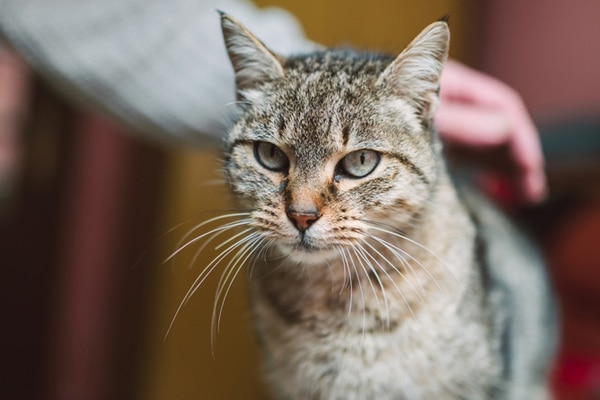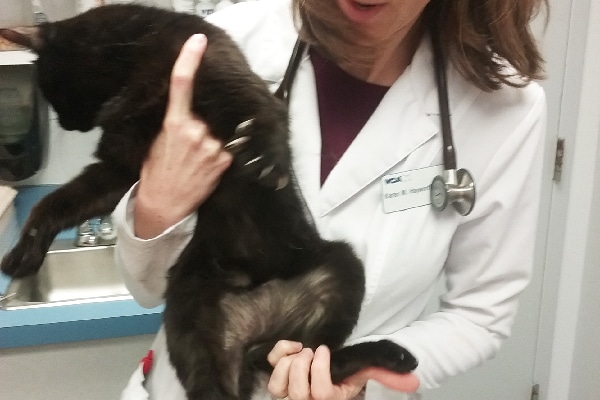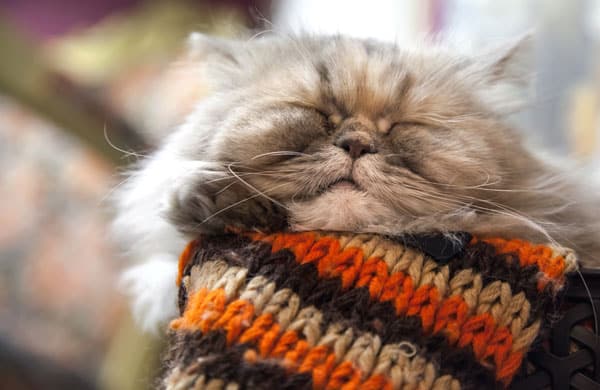One of last year’s litters of foster kittens brought more than joy and heart-melting cuteness to my house. Unfortunately, the outdoor kitties and their mom came with a pack of fleas, and the pests took up residence in the fur of my resident cat, G.G., who had a maddening itch. The itch soon turned into thinning hair on her belly, at the base of her tail and on her hind legs. So, is your cat losing hair? What causes cat hair loss? In G.G.’s case the hair loss turned out to be caused by a flea allergy. Let’s learn more about hair loss in cats, also known as alopecia in cats.
First, let’s define cat hair loss

First, what exactly is hair loss in cats? Photography by Ramon Espelt Photography / Shutterstock.
A cat losing hair — also called alopecia in cats — can be complete or partial and happens in felines for a variety of reasons, the most common of which is skin allergies, experts say. Dr. Fiona Bateman, assistant professor of dermatology at the University of Georgia’s Veterinary Teaching Hospital, regularly sees hair loss in cats at her clinic.
Is alopecia in cats ever ‘normal’?
Some cats have hereditary alopecia. For example, Sphynx cats are born without hair and never grow any.
Another type of normal hair loss is pinnal alopecia – hair loss on the outside of the ear pinnae — which is common in Siamese cats but usually resolves on its own. Many adult cats also experience preauricular alopecia — thinning of fur on the skin strip between the ears and the eyes, which is considered normal in cats, Dr. Hayworth says.
What about acquired alopecia in cats?
The rest of the cat population, which is born with normal fur, gets acquired alopecia — which is a symptom of a disease or condition, and not a disease itself. The veterinarian will diagnose the underlying condition, Dr. Bateman says.
With a cat losing hair, will that hair grow back?
The good news for cat parents is that this hair loss in cats usually doesn’t indicate a serious illness, and the hair can usually grow back, Dr. Bateman says. Dr. Hayworth, of VCA Northview Animal Hospital in the Pittsburgh suburbs, explains that how well a cat losing hair can be treated and reversed depends on the underlying cause.
“Generally, if we can reverse the cause, then we can get the hair to grow back,” Dr. Hayworth says. “This is especially true with over-grooming related to allergies. So, if you notice hair loss in your cat, it is definitely worth a trip to the doctor.”
These are six of the most common conditions behind a cat losing hair. Note that this isn’t an exhaustive list, as alopecia in cats is a broad condition with many potential factors.
1. Allergies — Particularly to Fleas — and Itching and Over-grooming

An example of G.G.’s hair loss due to a flea allergy. Photography courtesy Kellie B. Gormly.
Fleas can bite and irritate any cat, but some cats have a hypersensitivity to antigens within the flea saliva. These allergic cats get miserably itchy if they encounter fleas — and many of them will over-groom as a way of scratching the itch. The hair doesn’t just fall out; the cats actually lick it so much that they pull their hair out.
“It’s not that the hair can’t grow,” Dr. Bateman says. “These cats are licking it out faster than it can be replaced.
“About 90 percent of those cats we see in our clinic are over-grooming,” she says. “It is much less likely that the hair is falling out and not regrowing.”
Sometimes, a cat may engage in compulsive grooming because of neuropathic pain from nerve damage in the skin. In rare cases, a cat may groom too much and lose hair for psychogenic reasons, like anxiety after a stressful event; but, it’s more likely that cats licking off their hair are itching from flea allergy, Dr. Bateman says.
Mange, scabies and lice also can make a cat’s skin itch — leading to the same over-grooming and a cat losing hair. Mites, food allergies and environmental allergies also can cause itching and over-grooming.
2. Pain
Sometimes, a cat will lick an area of his body too much not because it itches, but because the tissue underneath the skin hurts, Dr. Bateman says. A cat with arthritis, for instance, may lick at the achy joint constantly because it is painful, and licking helps relieve the discomfort. The problem is, the cat licks away the hair, too.
Dr. Bateman once saw a cat who had a fractured rib. The kitty licked at the painful rub so much that he had become bald around that bone.
3. Infections
This isn’t as common a cause of a cat losing hair as allergies are, but it does happen. Cats with infectious conditions like staph infections and fungal infections like ringworm may lose hair in the affected areas, Dr. Hayworth and Dr. Bateman say.
4. Endocrine Disorders
A cat losing hair may have hyperthyroidism — an overactive thyroid, which causes weight loss and other symptoms. Outside of the thyroid, if cats have a hormonal imbalance and an increased level of steroids in the body, the hair follicles may die; and with abnormal hormone levels, new hair may not grow back. For instance, Cushing’s disease, a metabolic disorder that produces too much cortisol, may cause alopecia in cats.
5. Medication Side Effects
Transdermal prednisone causes alopecia and curling of the ear pinnae. Usually, Dr. Hayworth says, stopping the medication will reverse this condition.
6. Cancer
Thankfully, cancer is a rarely the reason for a cat losing hair; it is far more likely that your kitty’s hair loss is nothing serious. But neoplasia — a term for abnormal growths caused by uncontrolled division of cells — may cause hair loss in cats. Another serious condition that occurs secondary to cancer is paraneoplastic alopecia, which is hair loss associated with itching and moist skin, Dr. Hayworth says. However, these serious causes are rare.
The bottom line on hair loss in cats and alopecia in cats
Don’t panic over a cat losing hair — just take your cat to the veterinarian for an exam. “Chances are, it is not serious,” Dr. Bateman says. “But you don’t know that just by looking at the cat, which is why it’s important to get it checked out.”
Tell us: Have you had your own experience with a cat losing hair? What issue was at hand?
Concerned about hair loss yourself? Read this!
Thumbnail: Photography ©foaloce | Thinkstock.
This piece was originally published in 2018.
